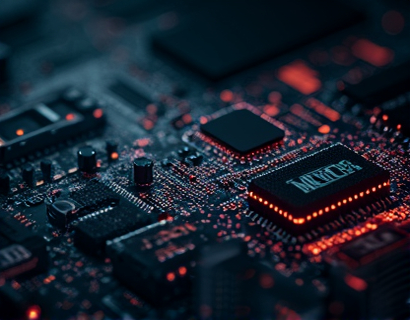Mastering Blockchain Scalability: Advanced Layer 2 Solutions for EVM-Enabled Development
In the rapidly evolving landscape of blockchain technology, scalability has emerged as a critical challenge for developers and innovators. As the demand for decentralized applications (dApps) grows, the need for efficient, secure, and cost-effective solutions becomes paramount. This article delves into advanced Layer 2 (L2) technologies specifically tailored for Ethereum Virtual Machine (EVM)-enabled blockchain development. By mastering these L2 solutions, developers can optimize scalability and efficiency, paving the way for faster, more secure, and more cost-effective dApps.
Understanding Layer 2 Solutions
Layer 2 solutions are designed to enhance the performance of blockchain networks without altering the underlying blockchain infrastructure. These solutions operate on top of the base layer (Layer 1) and aim to offload some of the computational and transactional burdens, thereby improving scalability. For EVM-enabled blockchains, L2 solutions are particularly crucial as they enable the execution of smart contracts while reducing gas costs and increasing transaction throughput.
Key Advantages of Layer 2 Solutions
One of the primary benefits of L2 solutions is their ability to significantly reduce transaction fees. By processing transactions off the main blockchain, L2 protocols minimize the congestion that drives up gas prices. This makes dApps more accessible and affordable for a broader user base. Additionally, L2 solutions enhance transaction speeds, allowing for near-instant confirmations, which is essential for user-friendly applications.
Security is another critical aspect where L2 solutions excel. While they offload some processing to a secondary layer, they maintain strong ties to the primary blockchain, ensuring that all transactions are ultimately secure and verifiable. This dual-layer approach not only improves performance but also maintains the integrity of the blockchain ecosystem.
Popular Layer 2 Protocols for EVM-Enabled Development
Several Layer 2 protocols have gained prominence in the EVM ecosystem, each offering unique features and benefits. Some of the most notable ones include Optimism, Arbitrum, and Polygon (formerly Matic).
Optimism
Optimism is a optimistic rollup solution that leverages zero-knowledge rollups to batch multiple transactions into a single transaction on the main chain. This approach significantly reduces gas costs and increases transaction throughput. Optimism's solution is particularly well-suited for applications that require high scalability and low latency, making it a popular choice for dApp developers.
Arbitrum
Arbitrum is another leading optimistic rollup protocol that provides a seamless development experience for EVM-based smart contracts. It uses a combination of optimistic execution and finality gadgets to ensure that transactions are both fast and secure. Arbitrum's compatibility with Solidity smart contracts makes it an attractive option for developers already familiar with the EVM ecosystem.
Polygon (Matic)
Polygon, formerly known as Matic, is a multi-channel solution that creates parallel chains (channels) to process transactions off the main Ethereum network. Each channel operates independently but remains linked to the main chain for finality. Polygon supports both optimistic and deterministic finality, offering flexibility and robustness. Its extensive library of tools and resources makes it a favorite among developers for building scalable dApps.
Implementing Layer 2 Solutions in EVM-Enabled Development
To effectively implement L2 solutions in EVM-enabled development, developers need to consider several key factors. First, understanding the specific requirements of the application is crucial. Different L2 protocols excel in different scenarios, so selecting the right one based on factors like transaction throughput, latency, and gas costs is essential.
Next, developers should familiarize themselves with the development tools and libraries provided by the chosen L2 protocol. For instance, Arbitrum offers a comprehensive SDK that simplifies the integration of optimistic rollups into existing EVM-based projects. Similarly, Optimism provides a user-friendly interface for deploying and managing rollup contracts.
Security remains a top priority. Developers must ensure that their L2 implementations adhere to best practices, such as proper validation of off-chain transactions and robust error handling. Testing is also critical, as it helps identify and mitigate potential vulnerabilities before deployment.
Case Studies: Successful L2 Implementations
Several successful dApps have leveraged Layer 2 solutions to achieve remarkable scalability and efficiency. One notable example is the decentralized finance (DeFi) platform, Aave, which has integrated Arbitrum to enhance its lending and borrowing services. By utilizing Arbitrum's optimistic rollups, Aave has seen a significant reduction in transaction fees and improved user experience.
Another example is the gaming platform, Axie Infinity, which has adopted Polygon to support its in-game transactions and asset transfers. The use of Polygon's multi-channel architecture has enabled Axie Infinity to handle a massive number of transactions with low latency and minimal costs, contributing to its widespread adoption.
Future Trends in Layer 2 Technology
The landscape of Layer 2 solutions is rapidly evolving, with ongoing research and development pushing the boundaries of what's possible. One emerging trend is the integration of Layer 2 and Layer 1 improvements, such as Ethereum 2.0's sharding mechanism, which promises to further enhance scalability and security.
Another area of focus is the development of cross-chain interoperability solutions, allowing L2 protocols to seamlessly interact with multiple blockchains. This will enable developers to build more complex and interconnected dApp ecosystems, opening up new possibilities for decentralized innovation.
Additionally, the adoption of machine learning and artificial intelligence in L2 solutions is gaining traction. These technologies can optimize transaction processing, predict network behavior, and enhance overall system efficiency, making L2 solutions even more powerful and reliable.
Conclusion
Mastering advanced Layer 2 solutions is essential for developers and innovators looking to build scalable, secure, and cost-effective decentralized applications on EVM-enabled blockchains. By leveraging protocols like Optimism, Arbitrum, and Polygon, developers can overcome the limitations of Layer 1 blockchains and unlock new potentials in the blockchain space. As the technology continues to evolve, the future of blockchain scalability looks promising, paving the way for a more decentralized and accessible digital world.










































